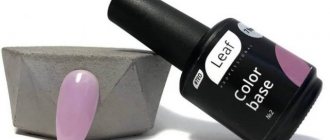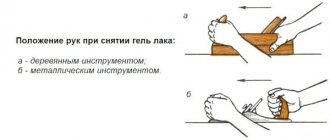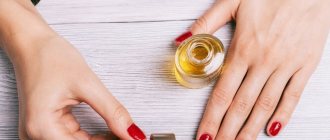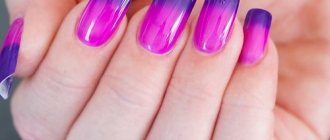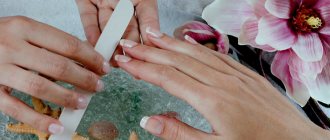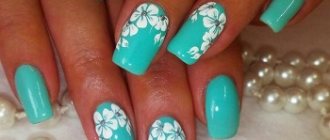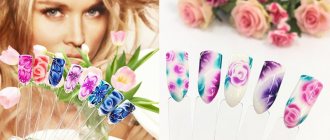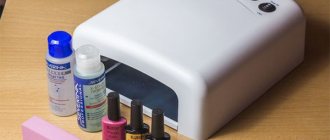Well-groomed hands, complemented by a beautiful coating of nail plates with varnish or a design, have long become one of the factors that distinguish a stylish and beautiful woman (girl). Therefore, it is not at all surprising that this issue is given due attention not only by women themselves, but also by the modern beauty industry. New technologies and methods for caring for hands and nails are proposed, which are designed to make the process itself not require such large and frequent time expenditures, and the result - more effective and durable.
It is precisely such new technologies that can be safely attributed to manicure, known as gel polish, which appeared relatively recently on the domestic market and is steadily winning the hearts of customers.
Having heard about the new product, many women wonder whether it is possible to paint their nails with varnish from this series? How is it different from other methods of manicure and nail coating? Is it harmful or not? Let's try to answer all these important questions for future users.
Is gel polish harmful?
To wear gel polish without harming your nails, you must first make sure that it does not contain formaldehyde, toluene, or dibutyl phthalate. You don't have to worry about the rest.
By the way, gel polishes usually contain:
- coloring pigments responsible for the color and saturation of the coating;
- photoinitiator is a component that absorbs the radiation of a UV lamp and protects the nail plate when drying gel polish. Non-toxic and harmless;
- The film former is a very ultraviolet-sensitive substance. Creates a stable film on the surface of the nails;
- Thinners are minor components; they can be chemical or natural. They are responsible for the consistency of the varnish; the adhesion of the coating to the nail plate depends on them;
- various fillers – provide viscosity, shine, etc. (for example, glitter) .
Do your nails need rest?
The main myth that is common among girls who apply decorative coating in the form of gel polish is that you need to periodically give your nails a rest for 2-3 months so that they recover and strengthen.
In fact, by choosing a competent nail technician and following all his instructions, you will maintain the health of your natural manicure, which will prevent it from gradually deteriorating. But, if you notice problems with your nails, you should remove the gel polish from them and leave them for several weeks for a healthy coating to partially grow back and local immunity to increase.
Keep in mind that shellac in most cases even benefits nails:
- Creating a dense decorative coating prevents accidental breakage of the plate, protects it from mechanical damage, detachments and chips. Because of this, the girl’s manicure always remains in a generally healthy state.
- Protection of the nail bed from external factors. The protective function is also to prevent the absorption of chemicals into the structure of the nails if a girl uses detergents without wearing gloves.
And problems with the nail bed most often arise due to the girl’s fault. For example, if a client removes gel polish on his own, and only then turns to a nail technician to design his nails, they will always deteriorate. This is due to the fact that in addition to the shellac, the upper stratum corneum of the bed is also torn off, severely damaging it.
Is UV lamp harmful for nails?
There is evidence that ultraviolet radiation can contribute to the development of melanoma on the hands and feet. Indeed, with prolonged exposure to ultraviolet radiation, the risk of DNA damage to skin cells and the nail matrix increases. But there's no need to panic, and here's why.
Lamps for drying gel polish usually use UVA or LED radiation. These ultraviolet rays are type A and do not burn the skin. But photoaging and an increased risk of skin cancer as side effects are quite possible under the influence of UVA rays. But only if the skin is not protected and not adapted to ultraviolet radiation.
The nail effectively protects the nail bed: it almost completely blocks UVB and allows only 0.5 - 2.5% UVA to pass through. We also note that the back of the hand, like the face, is more often than other parts of the body exposed to the sun without protection, which means it is well adapted to ultraviolet radiation. So no need to worry.
However, our expert recommends applying sunscreen with SPF 30+ to your skin about half an hour before your manicure.
You need to take a break from shellac: top myths about nail polishes and gels
Gel polish spoils nails, sea water strengthens them, UV lamps cause cancer... Have you heard that? Manicurist and co-owner of the Beauty Insider & KA2 salon Ekaterina Kirillina debunks popular myths about nail coatings. Spoiler: some of them turned out to be true.
In 1932, Charles Revson, founder of the Revlon brand, came up with the idea of adding colored pigments to clear varnishes. And approximately since then, nail coatings began to acquire myths. The advent of gels and gel polishes, which need to be baked in lamps, has spurred this process. Let's figure out which of this variety of horror stories is idle fiction, and which has a right to exist.
Myth 1: You must apply a base coat underneath the polish, otherwise your nails will get damaged.
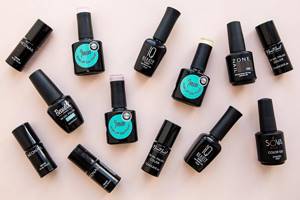
Myth. They won't spoil. And no, it cannot be said that without a base the varnish will necessarily hold up worse. It is worth applying the base so that the bright pigment does not eat into the nail plate. If the goal is simply to extend the life of the coating, you can do without it. It is enough to polish the nail with a file. Polishing will remove the top contaminated layer and seal the rest. The nails will not peel off and the coating will last longer.
Myth 2: medicinal varnish heals nails
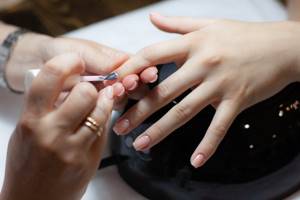
Myth. The nail (like hair) is dead tissue. The living nail plate is the one that is still under the cuticle. But it is impossible to apply medicinal varnish there, and it makes no sense on the rest of the surface: no vitamins will work.
Most of the rumors and controversies surround the medicinal (?) Trind coating. Yes, this is the only product that really holds the layers of the nail together and compacts it. True, this is due to formaldehyde, which is actually a toxic substance that can cause allergies. Plus, Trind is often used incorrectly: during application, it touches the cuticle, which causes severe irritation or burning. However, if you act carefully and paint only the nail plate, your nails will actually become stronger. Although, of course, this is not a treatment, but rather a mechanical gluing.
But cuticle oils really make sense - it is through it that the nail receives useful ingredients during growth.
Myth 3: Sea water strengthens nails
Myth. Many people remove the gel before going to the sea so that their nails are “saturated” with sea water. But this water does not nourish, but dries and crystallizes the plate: the salt penetrates under the scales, lifts them, and the plate becomes more porous. Moisture and fats evaporate from it, which give elasticity. Result: nails are dense and hard (and their free edge is whiter), but not flexible, so they often break and crumble.
Myth 4: you need to “rest” from gel polish and let your nails “breathe”
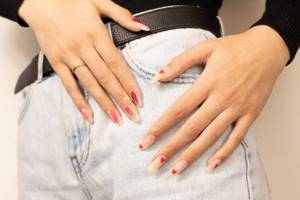
Myth. In fact, nails don't breathe. They, as already written above, are inanimate, so they do not need to “rest” from gel polish. There's no point in taking a break.
Myth 5: gel polish ruins your nails
This is partly true. If you have been wearing gel polish for more than six months, then most likely, after removal, you will find that your nails have become thin and sensitive. But it was not the gel that “spoiled” them, but your body: it got used to the fact that your nails are always protected and not injured, and has stopped making them dense and hard. Adapted.
The body needs to rebuild. How long it will take depends on the initial state of your nails and how the technician removed the gel for you. It is wrong to remove the coating together with the transparent base, “at the root”. Your nails will be completely defenseless. I recommend leaving a little base and gradually filing it off as the nail grows. The process will take about a month, but you will have a painless transition.
It also happens that the master removes the previous gel polish poorly, saws down the plate, and when the client asks what happened to the nails, he shifts the blame to the gel.
Myth 6: Pregnant women should not wear gel polish.
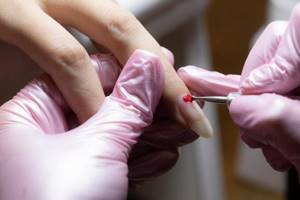
It is possible, but not every one.
Firstly, only the base comes into direct contact with the nail plate. All bases are made according to the same principle; they must contain a monomer - it adheres to the surface of the nail and ensures the stability of the coating.
The myth arose because previously there were only acid bases, which can cause allergies and contact dermatitis. In their composition, the role of a monomer is played by methacrylic acid (Hydroxyethyl Methacrylate, abbreviated as HEMA), which dries out the nail plate, but due to this, the coating holds well and is worn for a long time. HEMA has a very small molecule that combines well with water and can penetrate the skin - hence allergic reactions.
Different manufacturers add different amounts of this acid. If there is a lot of it, a sharp unpleasant odor appears during a manicure.
After the gel has hardened in a UV lamp, it becomes inert, does not smell and does not react in any way.
But now there are also acid-free or HEMA-free bases. Despite the name, there is still acid there. But not methacrylic, but, for example, ethyl methacrylic. It is more gentle and odorless.
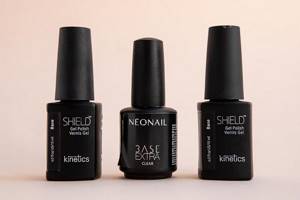
Acid-free bases: NeoNail Extra Strong, Pin.Code and Kinetics Shield Hema Free , and the brands TNL, Lianail, Kodi, Grattol, inGarden, Artex, Uno also have these. They can be used by pregnant women.
Secondly, hormonal levels change in pregnant women: nails may become more flexible or thin, or vice versa - harder. Therefore, the coating sometimes stops adhering abnormally quickly.
Thirdly, when removing the gel coating with the device, a lot of dust flies. This can be unpleasant for anyone, but pregnant women are sometimes especially sensitive. A face mask and a manicure vacuum cleaner on the master’s table help out.
Myth 7: Manicure lamps cause cancer
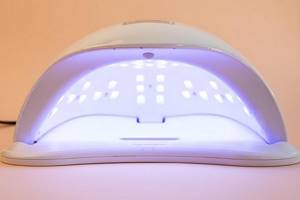
Myth. Although it did not arise out of nowhere. Apparatuses for polymerizing coatings do use ultraviolet radiation: UV lamps in the range from 350 to 400 nanometers, LED lamps from 375 to 410 nanometers. These are UVA rays - they penetrate the ozone layer all year round and provoke the synthesis of free radicals, which, in turn, lead to photoaging and the risk of melanoma.
The FDA recommends limiting the time you use these devices to no more than 10 minutes per arm per session for healthy people and avoiding if you have sun sensitivity, or if you are taking certain antibiotics, OCs, estrogens, or dietary supplements.
However, the latest study (May 2021) showed that for the radiation to become dangerous, your hand must be kept in the lamp for more than an hour. Whereas during a manicure, the hand is in the lamp for 1 to 10 minutes - and this, again, is the time allowed by the FDA.
And two more factors need to be taken into account: the nail completely blocks type B rays, and only 0.5–2.5% of type A rays pass through. In addition, the hands are most often exposed to the sun, so the skin there contains the largest number of melanocytes - cells that protect the body from UV radiation.
By the way, an interesting fact: in dentistry, UV lamps are also used to polymerize fillings. Their radiation lengths are almost identical to those used for manicure.
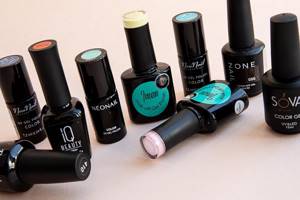
Myth 8: base, top and color gel must be the same brand
Not at all. Gel polishes have several different technologies for use. If the master knows the general principles of work, he can combine products from different brands. The main thing is that their technical characteristics match.
The master uses those materials that will give results: for example, he knows which base is best for wet nails, and which top coat to cover the design with a slider sticker so that it does not peel off.
Our expert
Master of manicure and pedicure, co-founder of the Beauty Insider & KA2 salon.
Why does fungus appear after gel polish?
It is not for nothing that it is recommended to wear gel polish for 2-3 weeks. Usually, after this period, the coating may begin to peel off: small voids form between the nail and the coating. Moisture gets into these areas (when washing hands, for example) and light penetrates poorly, especially with a dark, long-term coating. This creates ideal conditions for bacteria to multiply.
The formation of such peeling areas may not be noticed, but the risk of developing nail fungus should not be ignored.
Restoring nails using traditional methods does not work.
On Google you can find a bunch of wonderful stories of how many girls restored their nails after gel polish with sea salt, soda, iodine, yolk (hehe), and other food products.

Looking ahead, I want to say right away - this does NOT work.
Why does not it work? Yes, because nails are dense, keratinized plates. After improper removal of the coating, the nail plates rise like a fur coat, and the nail looks rough to the touch and thin. How can sea salt or oak bark decoction smooth out raised scales? No way.
To make it clearer, I’ll draw an analogy with wallpaper.
Wallpaper is washable, you can paint it, wash it, and then paint it again. Imagine that you have wallpaper on your hands instead of nails. After several careless color changing procedures, a piece of wallpaper has fallen off, what do you do? Apply glue and glue. No one would even think of making poultices from herbs or making an iodine mesh for wallpaper))).
The example with wallpaper may be crude, but it fully explains the essence of the issue. By the way, the main idea of restoring split nails is to try to stop further splitting and at the same time “glue” the split plates together. How this is written is described below.
- “Well, let’s say, you say, but what about these reviews”:

Everything is very simple here. If you smear the nail plate for 2-3 months with water, iodine, smart enamel, or something else, then only one thing will happen to the nail - it will grow back. It's like applying plantain to a broken arm. The effect will be the same) If you apply it and don’t disturb it for a couple of months, you’ll see that the bone will heal.
Or you can do nothing and the result will be the same.
Shellac manicure
Mistake #5: Mixing products from different manufacturers
We are talking about manicure products created by different brands. Despite the fact that many masters do not take this rule into account, celebrity stylists argue that in this case it is important to use the entire line of products from one manufacturer.
Products in one line of one brand are designed to ultimately achieve lasting results through effective teamwork. Therefore, you should not hesitate to ask your master questions and ask him to complete the entire cycle of work with products of one brand. Do the same when you do something at home.

